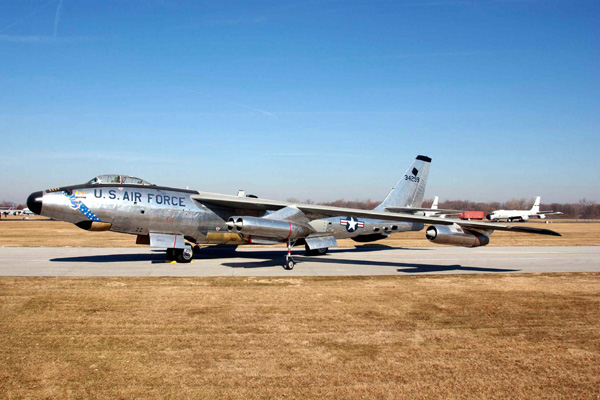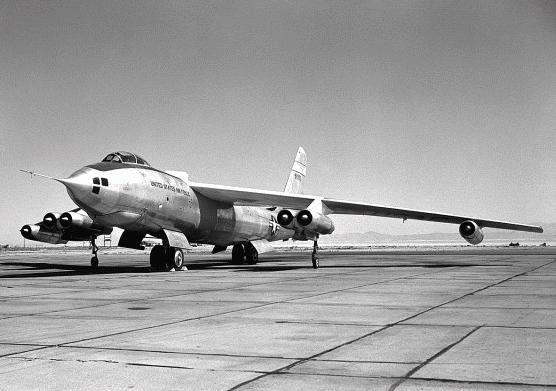
|
 |
Boeing B-47 Stratojet |
 |
 |
 |
 |
 |
|---|---|---|---|---|---|---|---|
 |
 |
 |
 |
 |
|||
 |
||
|
In the 1950s the Boeing B-47 Stratojet was the backbone of the Strategic Air Command. |
||
|
The third aircraft company to be awarded a development contract in the 1944 Air Force competition was Boeing with a straight wing design, which housed four jet engines in the fuselage. This configuration was given the original XB-47 label. Results of preliminary testing did not encourage this type of arrangement and tests continued on various designs with none offering the advanced performance sought.
In September 1945, a swept back wing was introduced as a result of reports studied in Germany after the war. This was what had been needed, but the next problem was the engine location. More than fifty different positions and combinations were tried before the final placing was decided. This became Boeing Model 450, or B-47. The arrowlike shape of the XB-47 introduced a new look into the field of heavy, high performance aircraft and on December 17, 1947, the swept wing bomber lifted from the runway on its first flight. |
| The testing that followed proved the soundness of the radical design, and production contracts were awarded that eventually made the Stratojet the backbone of the Strategic Air Command. Ten B-47As made up the original order and were followed by 398 B-47B aircraft. These two types were powered by six General Electric J47-GE-11 and -23 engines which gave up to 5,800 lb s.t.—1,800 pounds more than the prototype's J35-GE-7 units. Top speed of these types were well over 600 mph with a bombing capability extending over 3,000 miles. |
|
The B-47C was also known as the XB-56. Two B-47 aircraft were modified to XB-47Ds in 1955 when the inboard engine pods were replaced by Curtiss Wright YT49-W-1 turboprop engines of 10,000 horsepower.
The first B-47E was flown on January 30,1953 and this version was powered by six J47-GE-25A jets with 6,000 lb of s.t. or 7,200 lb s.t. using water injection. Two radar directed 20 mm cannons were mounted in the tail cone as sole defense since the speed of modern jet bombers makes conventional forward armament useless. Maximum bomb capacity was 20,000 pounds with a range of 1,600 miles, which could be extended by inflight refueling. Top speed was Mach 0.65, or 630 mph, at 10,000 feet, and cruise speed was 495 mph. Empty weight was approximately 80,000 pounds and normal loaded weight was 175,000 pounds with fuel capacity exceeding 17,000 gallons. Dimensions were typical of the series; span, 116 feet; length, 109 feet 10 inches; height, 27 feet 11 inches; wing area, 1,428 square feet. The Stratojet was the first production bomber to utilize the unique "bicycle" type landing gear, although not the first aircraft to be so equipped. Other variations of the B-47 include the reconnaissance and weather-photo types as the RB-47E and RB-47K. The ERB-47H was a radar loaded Stratojet which carried a crew of five instead of the normal three. As B-47s were being phased out of active service, many of them were converted to QB-47 radio-control drones for use in missile evaluation tests.

The Stratojet was the first production bomber to utilize "bicycle" type landing gear. |
| Specifications: | |
|---|---|
| Boeing B-47E Stratojet | |
| Dimensions: | |
| Wing span: | 116 ft. 0 in (35.35 m) |
| Length: | 109 ft. 10 in (33.49 m) |
| Height: | 27 ft. 11 in (8.50 m) |
| Wing area: | 1,428 ft/sq (435 m/sq) |
| Weights: | |
| Empty: | 80,000 pounds (36,287 kg) |
| Loaded weight: | 175,000 pounds (79,378 kg) |
| Performance: | |
| Speed: |
Mach 0.65, or 630 mph (1013 k/h), at 10,000 ft (3048 m), cruising at 495 mph (796 k/h). |
| Fuel capacity: | 17,000 gallons (64,352 lt) |
| Range: | 1,600 miles (2,574 km) |
| Powerplant: | |
|
Six J47-GE-25A turbojets with 6,000 pounds of thrust, or 7,200 pounds of thrust, using water injection for takeoff. | |
| Armament: | |
|
Two radar directed 20 mm cannon mounted in the tail cone with a maximum bomb capacity of 20,000 lbs (9,071 kg). | |
© The Aviation History On-Line Museum. All rights reserved.
Created November 27, 2001. Updated October 13, 2013.